feel the burn
It starts with a slowly building warmth, like tinder catching under a campfire, a precursor of the pungent punch soon to come. Brightness follows — bursts of tangy citrus, grassy freshness, and floral sweetness that build toward an earthy, smoky complexity.
But before you can fully savor the flavor, the heat comes alive. Your lips sting, your eyes water, your nose runs, and your brain, sensing danger, screams stop!!
It’s more than just a sensation; it’s a challenge, as if the pepper you’re eating dares you to keep going even as the heat keeps rising. And then… something magical happens. The endorphins kick in with a primal, exhilarating rush, like running through a forest at full tilt or plunging into a freezing lake. For those who crave spice, this isn’t pain; it’s a spark. It wakes you up. And in that moment you realize that a chili pepper isn’t just a fruit. It’s a story. A tiny, wild, untamed burst of nature that refuses to be ignored.
spice up your knowledge
There is way more to peppers than I could ever hope to fit in one blog article; heck, there are whole (large) websites that are completely devoted to them. But they are also way too awesome not to include here, either, so… join me and explore some of the awesomeness, from the science behind spiciness to the vibrant culture surrounding chili peppers. Whether you’re a curious beginner or a seasoned chili head, there’s something here for everyone. Here’s what you’ll discover:
- the science of spice. what makes chili peppers spicy, how capsaicin works, and why we feel the burn
- chili pepper origins. the fascinating history and cultural significance of chili peppers around the world
- measuring heat. the story of the scoville scale and how modern science quantifies spiciness
- know your peppers. a breakdown of chili pepper varieties by heat level, with recipes to match
- modern chili pepper culture. the psychology behind the popularity of spicy foods, the hot sauce boom, and extreme chili pepper challenges
- practical tips. how to cook with chili peppers, grow your own, and handle the heat like a pro
- facts, trivia, and myths. fun things to know about chilies and misconceptions about them
Prepare to embrace the heat and uncover the incredible world of chili peppers — there’s much more to them than just their fiery kick!
spice up your knowledge
As you probably already know, the burn we feel when we eat a chili pepper comes from a highly pungent compound called capsaicin, which is an irritant for humans and other mammals. Chilies are the only significant source of capsaicin, which is present in varying degrees across all varieties, from the mildest poblano peppers to Scotch bonnet peppers.

capsaicin formation
Capsaicin is formed through a fascinating chemical process in chili plants. The phenylpropanoid pathway, a metabolic process in plants, produces essential compounds for growth, structure, and stress responses. One of these is an aralkylamino compound called vanillylamine.
Simultaneously, a fatty acid metabolism pathway produces 8-methyl-6-nonenoyl-CoA, a branched-chain fatty acid intermediate involved in the plant’s energy production and lipid biosynthesis.
When vanillylamine is combined with 8-methyl-6-nonenoyl-CoA and an enzyme called capsaicin synthase, the result is capsaicin: a colorless, crystalline compound responsible for the pleasure (and pain!) we experience when it hits our taste receptors.

have a taste
Life wouldn’t be as sweet — or spicy — without the specialized cells lining our tongue, throat, and mouth, commonly known as taste buds. These “gustatory receptor cells” are akin to the sensory monitors our bodies use to track oxygen and CO₂ levels in the blood. They respond to the chemical makeup of food, helping us interpret flavors as “taste.”
Olfactory receptors in the nose work alongside these taste receptors to identify five basic taste categories: sweet, sour, salty, bitter, and umami. Taste receptor cells release neurotransmitters that activate nearby nerve cells, relaying signals through cranial nerves to the brain’s primary gustatory cortex. Here, our brain deciphers the chemical information, determines whether it’s safe, categorizes the taste, and decides whether or not we like it.
With all this talk about taste, you might think that the burn of chile peppers works like this as well, but – surprise! – it does not. While taste buds bring us those five basic flavors, another type of sensory organ is the key to our relationship with capsaicin: the TRPV1 receptor.
Imagine taking a big bite of fiery, homemade chili con carne, crafted with your secret blend of guajillos, anchos, and chiles de árbol. That spoonful, though smoothed slightly by sweet tomatoes, savory meats, and aromatic spices, still packs a good dose of heat.
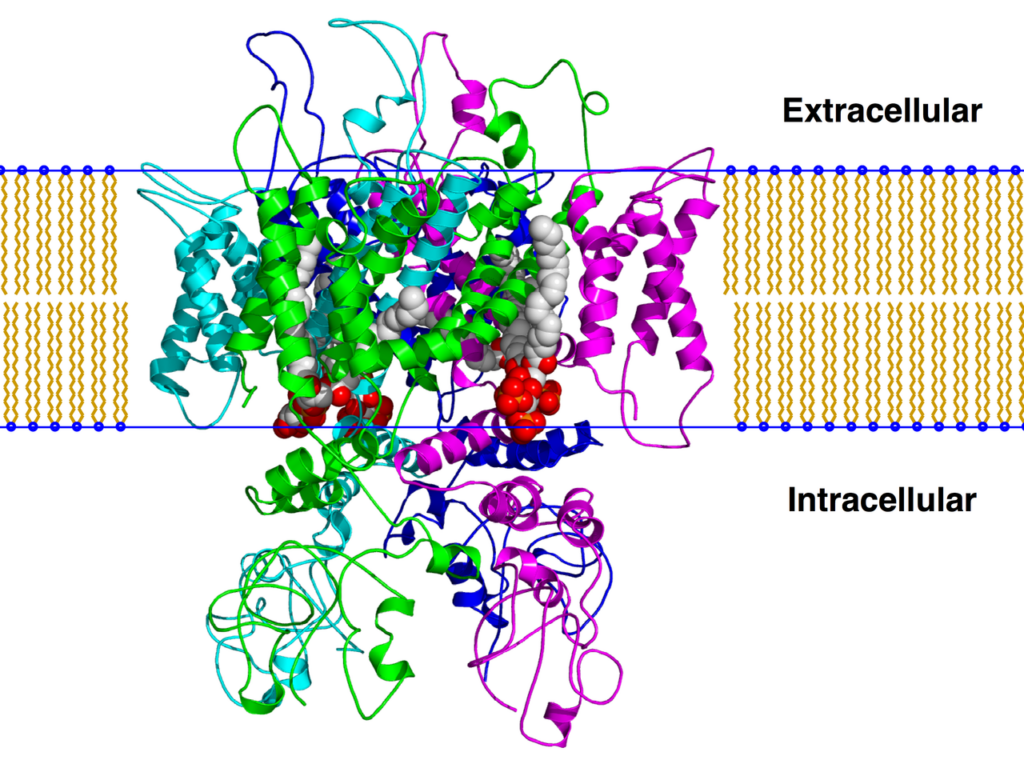
This is where TRPV1 receptors take center stage. These specialized protein complexes, also known as transient receptor potential vanilloid 1 channels or TRPV1, are embedded in the membranes of sensory nerve cells. They act as ion channels, designed to open up in response to certain physical or chemical stimuli. While their main job is to sense heat, whether from high temperatures or spicy compounds like capsaicin, they also respond to acidity and even physical irritation.
When capsaicin binds to a TRPV1 receptor, it triggers the channel to open, allowing positively charged ions, such as calcium and sodium, to flood into the nerve cell. This influx generates an electrical signal that travels along sensory neurons to the brain, where it is interpreted as pain or heat. In essence, your body “thinks” it’s on fire, even though no actual temperature change has occurred.
To protect you, your brain initiates countermeasures. It may prompt you to spit out the source of irritation, increase blood flow to cool the area (hence the flushing and sweating), and stimulate tear production to “wash out” the irritant. But here’s where it gets interesting: while your brain is working to shield you from harm, it also releases endorphins—your body’s natural painkillers. This rush of endorphins can create a sense of euphoria, which explains why some people find themselves drawn to the burn rather than deterred by it.
hot takes: other effects of capsaicin on the body
Capsaicin doesn’t just make your mouth burn; it has a whole range of effects on various parts of the body. Here’s how it impacts the key areas involved in processing spicy foods:
Mouth. Capsaicin binds to TRPV1 receptors in the mouth, simulating the sensation of intense heat. This sets off a pain response, making your tongue feel like it’s on fire and causing your mouth to flood with saliva in an attempt to wash away the burn.
Throat. As you swallow, capsaicin can stimulate the sensitive tissues in your throat, causing a burning sensation. This sometimes leads to coughing or a reflexive tightening of the airway in response to the perceived irritation.
Stomach. Once capsaicin reaches your stomach, it can irritate the lining, especially if eaten in large quantities or on an empty stomach. This irritation can result in a burning sensation, discomfort, or even nausea. However, for most people, the stomach’s mucus lining and digestive processes handle capsaicin without long-term issues.
Intestines. In the intestines, capsaicin can act as a stimulant, increasing motility (the speed at which food moves through the digestive tract). For some, this can lead to cramping or diarrhea, particularly if they’re not accustomed to spicy foods. Capsaicin also interacts with nerve endings in the intestines, which is why some people experience a “second wave” of burning during digestion.
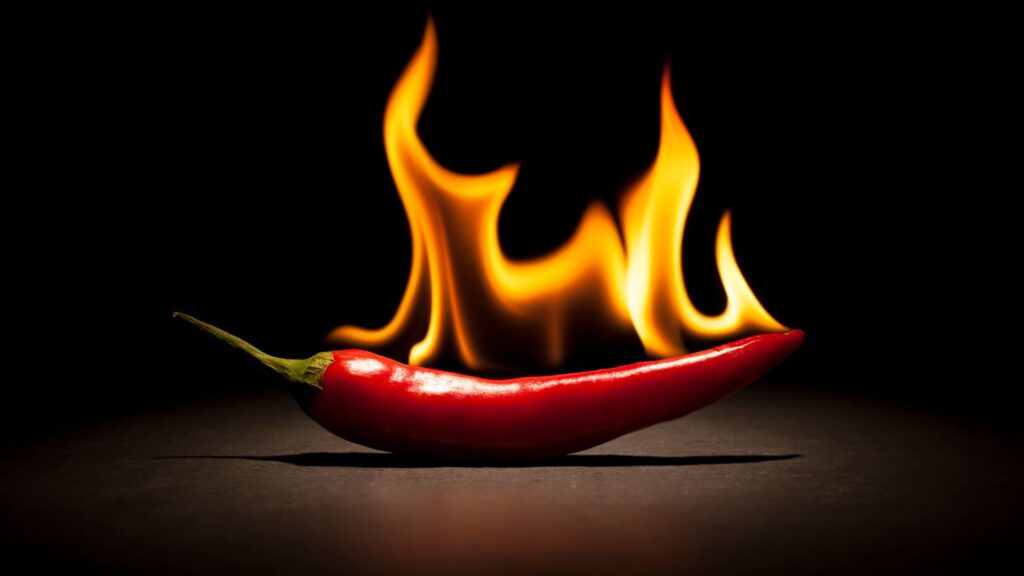
While these effects can feel intense, they are generally temporary and harmless for most people. For seasoned chili lovers, the body often adapts to capsaicin exposure over time, reducing sensitivity to its fiery impact.
just how much heat can we eat?
The human body is remarkably resilient, even when it comes to handling capsaicin. How much heat a person can handle depends on their individual sensitivity, past exposure, and ability to build up a resistance over time.
In general, the lethal dose of capsaicin is estimated to be around 190 milligrams per kilogram of body weight. For a person weighing 150 pounds, this equates to approximately 13 grams of pure capsaicin, a virtually impossible amount to consume from chili peppers alone, as it would require eating over 1,300 Carolina Reapers (one of the hottest chilies in the world).
However, long before reaching such extreme levels, the body will react with intense pain, sweating, vomiting, and other defenses designed to prevent further intake. For most people, even small amounts of capsaicin can feel overwhelming, but seasoned chili enthusiasts often build up a tolerance that allows them to enjoy much higher levels of spice.
While capsaicin can cause discomfort and temporary distress, it’s generally not dangerous in culinary amounts. Moderation is key, and if you’re experimenting with superhot chilies, it’s always wise to start small!
If the “heat” we feel when eating chiles is thanks to capsaicin directly targeting TRPV1, what about other foods that seem to burn and sting?
the spicy alternatives
There are only a few foods that trigger a TRPV1 reaction, mostly because the receptor is specifically tuned to detect heat-like sensations and chemical irritations… and most foods don’t produce compounds that mimic these effects.
Ingredients like chile peppers, black pepper, and ginger have evolved specific chemical defenses — capsaicin in peppers, piperine in black pepper, and gingerol in ginger — to deter herbivores and pathogens, which naturally activate our TRPV1 receptors.
There is another receptor that is related to TRPV1, however, that is responsible for a similar, if less intense, effect when triggered by some foods and ingredients: TRPA1.
TRPA1
Unlike TRPV1, which detects heat-related stimuli, TRPA1 receptors respond to chemical irritants more broadly. These receptors are responsible for the sharp, pungent sensations we experience when consuming foods like mustard, wasabi, garlic, and certain forms of alcohol. TRPA1 activation doesn’t create the burning heat of capsaicin but instead produces a sharp tingling or stinging sensation.
TRPA1 receptors are less commonly discussed than their TRPV1 counterparts, but their ability to detect chemical irritants gives rise to unique sensory experiences. From the sinus-clearing punch of wasabi to the warming spice of cinnamon, TRPA1 adds a distinctive dimension to our perception of flavor.
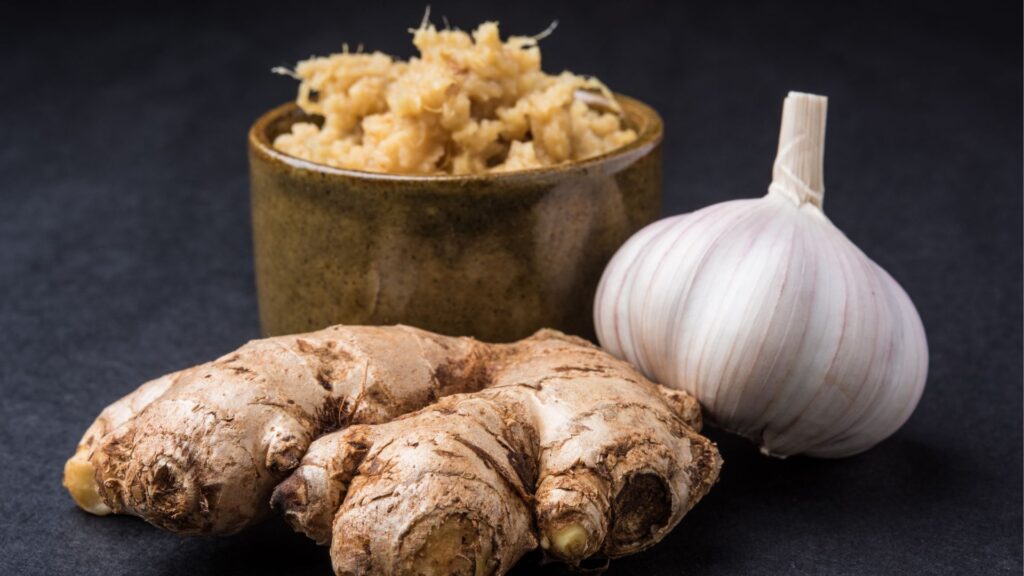
foods and ingredients that activate TRVA1
- Mustard: The spicy kick in mustard comes from allyl isothiocyanate (AITC), a compound that activates TRPA1 receptors. This explains why mustard’s pungency is felt sharply in the nose and sinuses.
- Wasabi and Horseradish: These contain isothiocyanates, volatile compounds that stimulate TRPA1 receptors, creating a distinctive sharp, nasal sensation.
- Garlic: Compounds like allicin in fresh garlic also activate TRPA1 receptors, contributing to its sharp, biting flavor.
- Cinnamon: Specifically cinnamaldehyde, which provides cinnamon’s warming sensation, can trigger TRPA1 activation.
- Certain Alcohols: High-proof alcohols, such as ethanol in liquors, can weakly activate TRPA1 receptors, producing a mild burning or warming sensation. Methanol (wood alcohol) and isopropanol (rubbing alcohol), while not consumable, also strongly activate TRPA1 receptors and cause irritation.
bridging the sensations
TRPV1 and TRPA1 receptors detect a wide range of chemical compounds that trigger sensations of heat, irritation, and spice. While these responses originally evolved as plant defenses, humans have embraced them for their bold flavors and sensory thrill.
As we move beyond the science of how we perceive spiciness, let’s delve into the fascinating history of the chili pepper, an ancient fruit that has traveled across continents, shaped cuisines, and become a cornerstone of cultures around the world.
a brief history of the chili pepper
For millennia, the spicy bite of chili peppers has captivated human societies. From their origins in ancient Mesoamerican civilizations to their status as a global culinary staple, these little flavor bombs have left a profound impact on cultures and cuisines around the world.
first fruits
Chili peppers were first cultivated thousands of years ago in Central and South America. Ancient civilizations like the Aztecs and Mayans revered them, believing they possessed both spiritual and medicinal powers. Chilies featured prominently in religious ceremonies, healing practices, and everyday diets, offering both flavor and symbolic meaning.

Archaeological evidence suggests that chili peppers were domesticated as early as 6,000 BCE, making them one of the earliest cultivated crops in the Americas. Indigenous peoples valued chilies not only because they were tasty… they could also help to preserve food, repel pests, and even bump up the nutritional benefits of their meals.
spice trek: the first generation
The spread of chili peppers beyond the Americas began in the late 15th century. Mistaking chilies for a type of black pepper (hence their name), European explorers brought them back to Spain and Portugal, where they quickly gained popularity.
Through trade routes established by European empires, chili peppers traveled far and wide. They reached Asia, Africa, and the Middle East, where they were embraced and integrated into traditional cuisines. By the 16th century, chilies had become ubiquitous in dishes like Indian curries, Thai stir-fries, and Ethiopian stews.
a global love affair
The adaptability of the chili pepper plant has allowed it to be cultivated in diverse climates by many cultures throughout history, evolving from its ancient origins in the Americas to become a universal culinary treasure. Today, chilies are a staple in cuisines all over the world, bringing vibrancy and depth to dishes of every heat level.
Beyond their culinary contributions, chili peppers have also inspired art, folklore, and even competitive eating contests. To this day, they remain popular and well-loved for their heat, flavor, and mystique.
regional highlights
- Mexico. salsa and mole as staples
- India. spices in curries and chutneys
- Korea. kimchi and gochujang
- Thailand. Thai chilies and their influence on global cuisine
- U.S. hot sauce culture and bbq rubs
the scoville scale
It’s one thing to feel the burn, but how do you measure it? That’s where the Scoville Scale comes in. Developed over a century ago, this spicy standard has evolved from a subjective taste test into a modern scientific method that ranks peppers from mild to mouth-melting. In the next section, we’ll dive into the fascinating story behind the scale that every chili head lives by.

wilbur scoville
Wilbur Scoville (1865-1942) was an influential American pharmacist and researcher. Best known for his groundbreaking work devising a method to measure the pungency of chili peppers, Scoville bridged the fields of pharmacy and food science, leaving a legacy that continues to impact both industries today.
early life and education
At the age of 14, Scoville began working for a local druggist, sparking his lifelong interest in pharmacy. He went on to attend the Massachusetts College of Pharmacy (now MCPHS University) in Boston, earning a Graduate of Pharmacy (PhG) degree in 1889. He returned to the college as a professor of pharmacy and applied pharmacy from 1892 to 1904.
contributions to pharmacy
In 1895, Scoville authored The Art of Compounding, a seminal work that addressed topics such as prescription drug formulation, contraindications, drug interactions, manufacturing techniques, and sterilization procedures. The book became a trusted pharmacological reference, with eight editions published. It remained in use until the early 1960s.
pioneering the scoville heat scale
In 1907, Scoville joined the pharmaceutical company Parke-Davis as a researcher. It was there, in 1912, that he developed the Scoville Organoleptic Test, a precursor of the Scoville Heat Scale.
legacy and recognition
Scoville’s work not only provided a scientific approach to measuring spiciness but also paved the way for understanding the role of capsaicin in food and medicine. On January 22, 2016, Google honored him with an interactive Google Doodle in celebration of his birthday. The doodle featured a game where players battled pepper characters by hurling balls of ice cream, a playful nod to the cooling effects of dairy on spicy foods.
Wilbur Scoville’s innovative spirit and dedication to precision have made him an enduring figure in both science and culinary history. His contributions continue to influence pharmacists, food scientists, and spice enthusiasts worldwide.
so what is the scoville scale, exactly?
Wilbur Scoville’s original method involved diluting chili pepper extracts in sugar water and having a panel of human testers determine how much dilution was required for the heat to become imperceptible. The result, measured in Scoville Heat Units (SHU), quantified the spiciness of peppers, and the scale became a standard metric in the food and spice industries.

how hot is hot: modern tests for pungency
You might be thinking to yourself, “Wait! Isn’t this system kind of subjective?” and the answer is: “Definitely!” However, these days we don’t have to rely on intrepid pepper tasters to measure how much fiery sting a new pepper carries within its flesh; we have high-performance liquid chromatography (HPLC).
HPLC measures the concentration of capsaicinoids in parts per million (PPM), which can be converted to Scoville Heat Units (SHU) by multiplying the PPM by 16. The American Spice Trade Association (ASTA), however, uses an alternative method that uses pungency units, defined as one part capsaicin per million parts dried pepper mass. The logarithmic nature of the scale means that even slight variations in capsaicinoid content can result in noticeable differences in perceived spiciness. Heat perception is influenced not only by these levels but also by how capsaicin interacts with receptors, making the experience more complex than simple arithmetic.
the usual suspects, ranked: chili peppers by heat level
So this is the part where we are supposed to draw a little diagram of peppers all in a row, from the lowly 0 SHU bell pepper to the 2.6 million plus SHU Pepper X. But to be honest, the top hottie gets bumped every couple of years, and you’ve seen it before. Let’s instead look at the different heat categories as defined by the ASTA.
mild (0 – 2500 SHU)
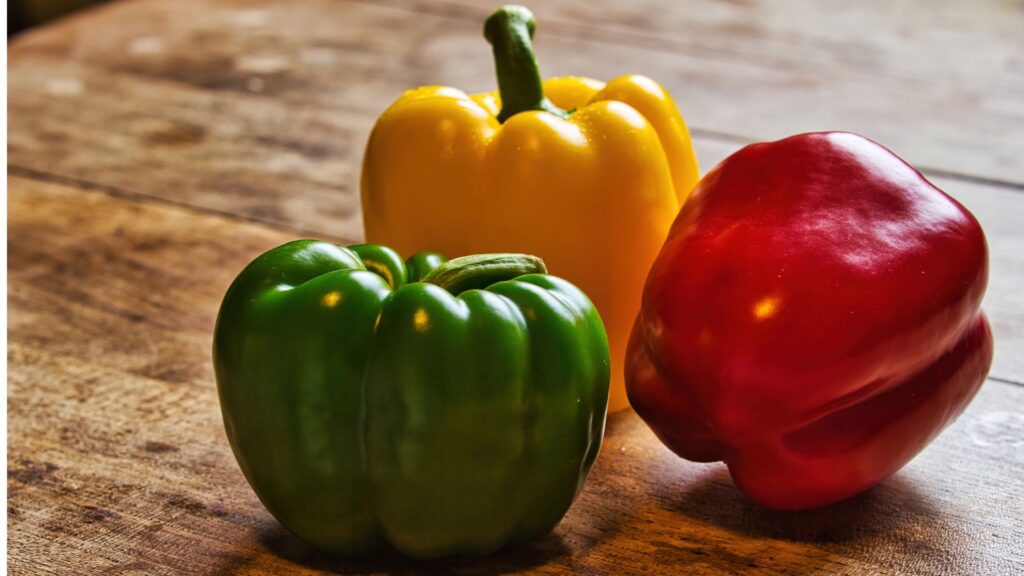
bell pepper
Bell peppers are unique in that they are the only capsicum that produces no capsaicin whatsoever. If you live in the United States, chances are you eat upwards of 11 pounds of fresh green red, yellow, and/or orange peppers each year! While native to North America, over 1.2 million metric tons of bell peppers are imported to the States each year valued at over $1.5 billion!!
Their crunch and mild, grassy (for greens) or sweet (for the riper ones) flavor makes them a popular choice for the whole family, and they are found on dinner tables across the world. They can be stuffed, blended into salsa, or added to salads, stir-fries, casseroles, soups, sandwiches, tacos, chili, curry… the list goes on.
One of my favorite recipes for green and red bells is Pepper Pepper Salt and Pepper Chicken.
poblano
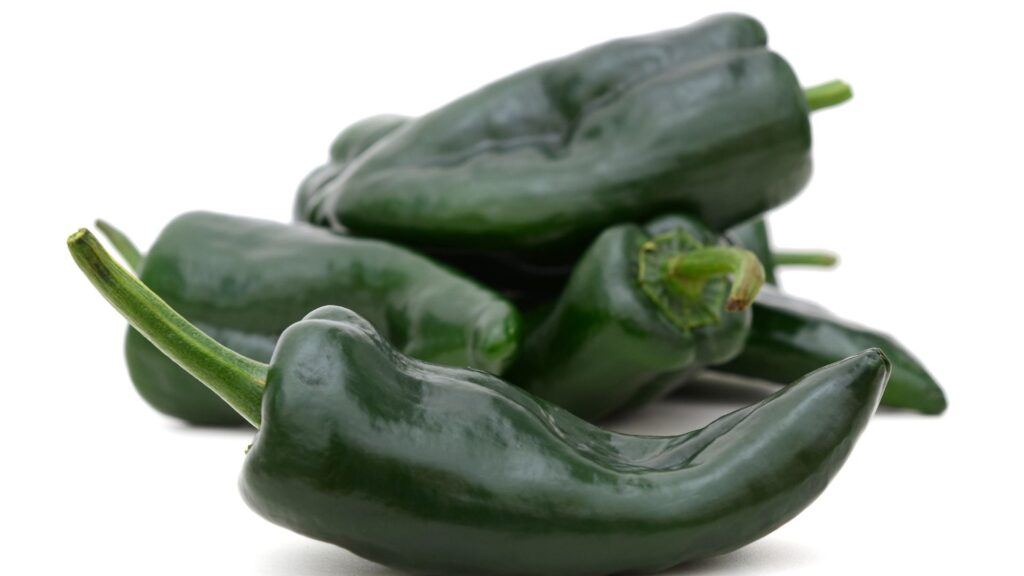
Poblanos clock in around 1000-2000 SHU and are loved for their mild heat and rich, earthy flavor. Native to Puebla, Mexico, these medium-sized green peppers often find their way into traditional dishes. They have thick walls that make them an excellent choice for stuffing or grilling, and their manageable spice level earns them a place in sautees, soups, stews, casseroles, and salsas.
While generally mild, beware of the occasional outlier that packs more heat than expected… it’s kind of like playing Russian roulette with Scoville! They remain, however, a great introduction for people who want to venture beyond the bell peppers but aren’t ready to dive into the world of spicier chilies just yet.
One of my favorite recipes for green and red bells is Creamy Roasted Poblano Soup.
medium (2500 – 30,000 SHU)
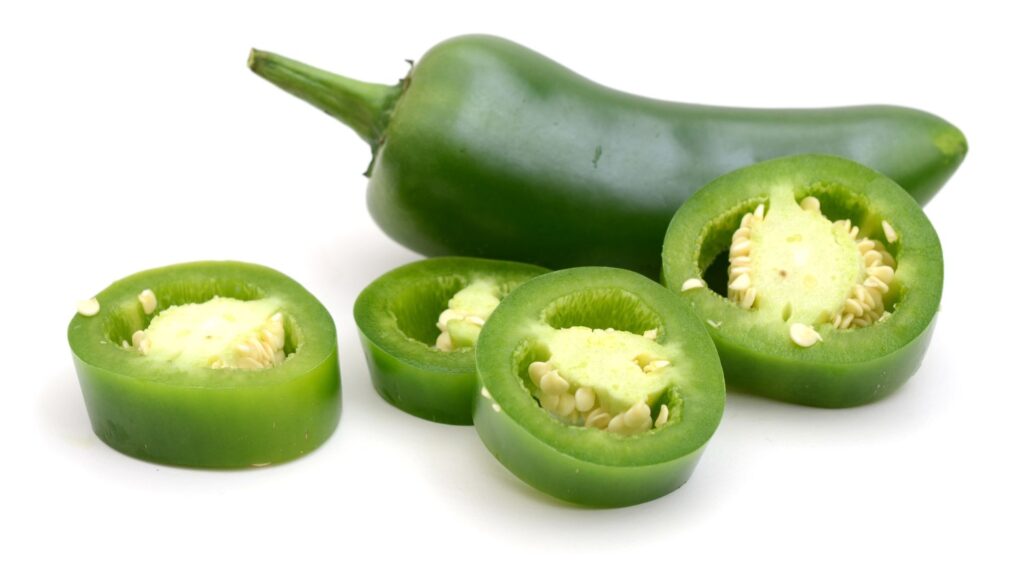
jalapeño
Jalapeño peppers are the spicy rockstars of the chili world. Originally hailing from Mexico, these small, glossy green or red peppers pack a punch of heat while still being mild enough for most spice lovers to enjoy. On average, they clock in at 2,500 to 8,000 Scoville Heat Units (SHU), making them a versatile choice for adding a kick to your favorite dishes.
Their bright, grassy, slightly tangy flavor makes jalapeños a go-to for salsas, nachos, burgers, and even pickling. You’ll also find them sliced and scattered on pizzas, stuffed with cream cheese and wrapped in bacon, or blended into hot sauces. When smoked and dried, they become the smoky, rich chipotle pepper—a whole new way to savor their flavor.
Jalapeños are beloved for their consistent heat, but as with poblanos, every so often a rogue pepper will catch you off guard with a surprising jolt of heat! You may also find the occasional mild-mannered jalapeño with almost no heat. While they can be stealthy in this regard, look for small, brown lines in the skin of a jalapeño; called “corking,” they may tell you something about the heat level. Peppers with more of these tend to be hotter, while the smoother ones lean toward the mild side. Jalapeños are a healthy choice, rich in vitamin C and capsaicin, which is said to boost metabolism and release feel-good endorphins.
One of my favorite ways to enjoy jalapeños is in Jalapeño Chicken & Spinach Bake.
hot (30,000 – 100,000 SHU)
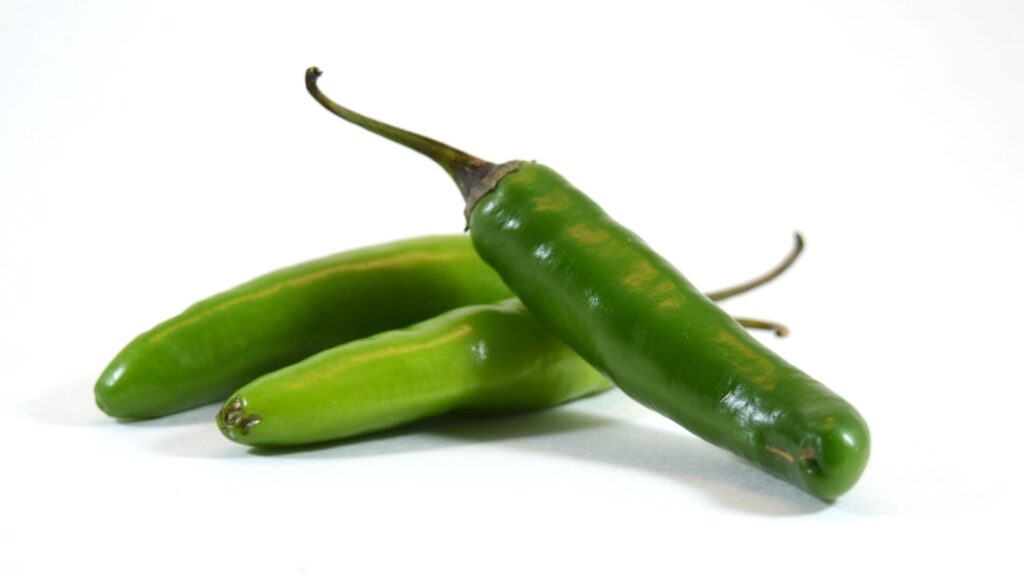
serrano
Serrano peppers are the fiery cousins of the jalapeño, offering a sharp, clean heat that’s not for the faint of heart. Native to the mountainous regions of Mexico, these slender peppers pack a serious punch, with a heat level that’s two to five times hotter than your average jalapeño.
Known for their bright, fresh flavor and crisp texture, serranos are often used raw in salsas, guacamole, and pico de gallo to bring a zesty kick. I particularly like to use them when I want a dish to retain most of the heat that is often lost in the cooking process, so tread carefully if you’re particularly sensitive! Serranos are great for spice enthusiasts looking to step up from jalapeños without diving headfirst into the volcanic realm of habaneros or ghost peppers.
One of my favorite recipes using serranos is Goan Style Pork Vindaloo.
extra hot (100,000 – 300,000 SHU)
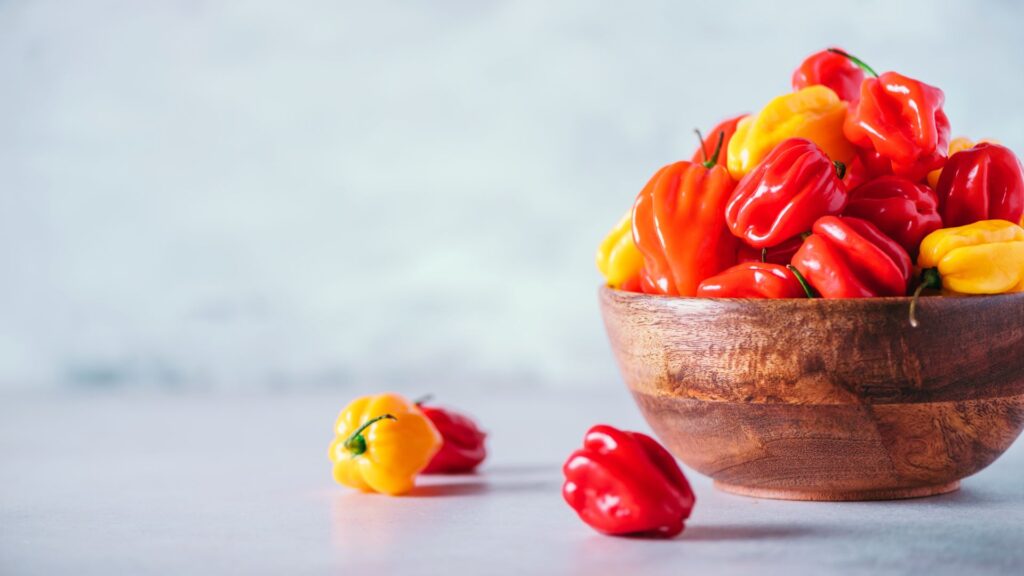
scotch bonnet
Scotch Bonnet peppers are the crown jewels of Caribbean cuisine, delivering a blazing heat matched only by their fruity, tropical sweetness. Named for their resemblance to a tam o’ shanter hat, these small, wrinkly peppers pack a fiery punch, ranging from 100,000 to 350,000 Scoville Heat Units (SHU)—right up there with habaneros. But don’t let their heat scare you off; their complex flavor makes them an irreplaceable ingredient in many island dishes.
Scotch Bonnets are the star of jerk seasoning, giving it that unmistakable kick and fruity depth. They’re also a staple in hot sauces, marinades, and stews like Jamaica’s escovitch fish or Trinidad’s pepper pot. Their heat is bold, but the bright, almost citrusy flavor makes them an excellent choice for balancing rich, hearty dishes or adding a spark to tropical recipes.
Fair warning: these peppers are not for the faint of heart. Always handle them with care, and if you’re new to them, start small and taste as you go—these peppers can sneak up on you fast! But for spice lovers, Scotch Bonnets are the key to unlocking that authentic Caribbean heat and flavor.
One of my favorite recipes featuring Scotch Bonnets is Jamaican Steamed Cabbage.
extremely hot (300,000 – 1,000,000 SHU)
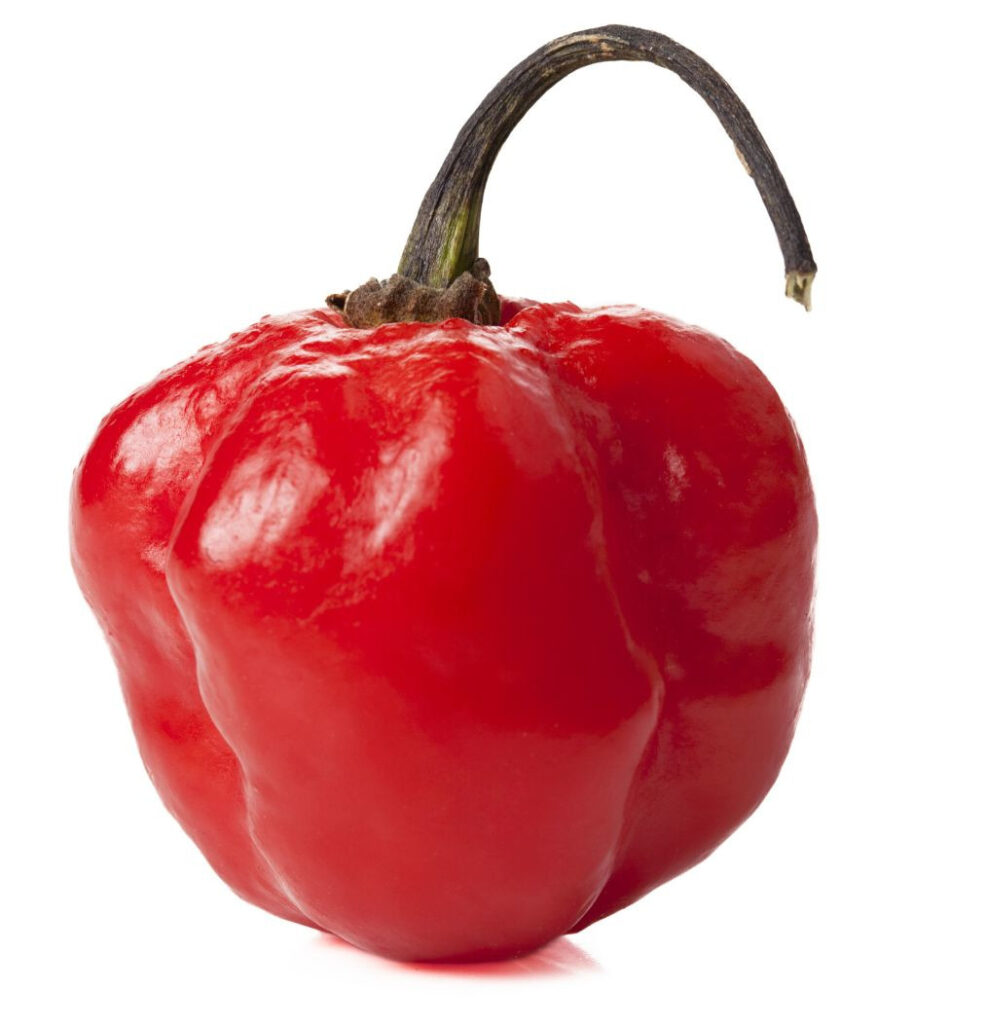
red savina habanero
The Red Savina habanero is more than just a chili pepper — it’s a legend. Once recognized as the world’s hottest pepper (before being dethroned by even spicier varieties), this scorching red dynamo is about 50 times hotter than a jalapeño! But this pepper isn’t just about heat; its intense, fruity flavor makes it a favorite for those who dare to tread into extreme chili territory.
The Red Savina is a selective cultivar of the habanero, bred for its extraordinary heat and vibrant red hue. It’s often used in hot sauces, salsas, and marinades where just a touch can transform a dish into a blazing masterpiece. You’ll also find it starring in chili recipes, barbecue sauces, and Caribbean dishes that balance its heat with bold, savory flavors.
If you’re planning to cook with Red Savinas, proceed with extreme caution; these peppers are not for the novice. Always wear gloves when handling them, and keep in mind that a little goes a very long way. For those brave enough to take the plunge, they offer a flavor that’s as unforgettable as their heat.
One of my favorite recipes showcasing the Red Savina is Thermonuclear Crazy Person Wings.
superhot (1,000,000+ SHU)
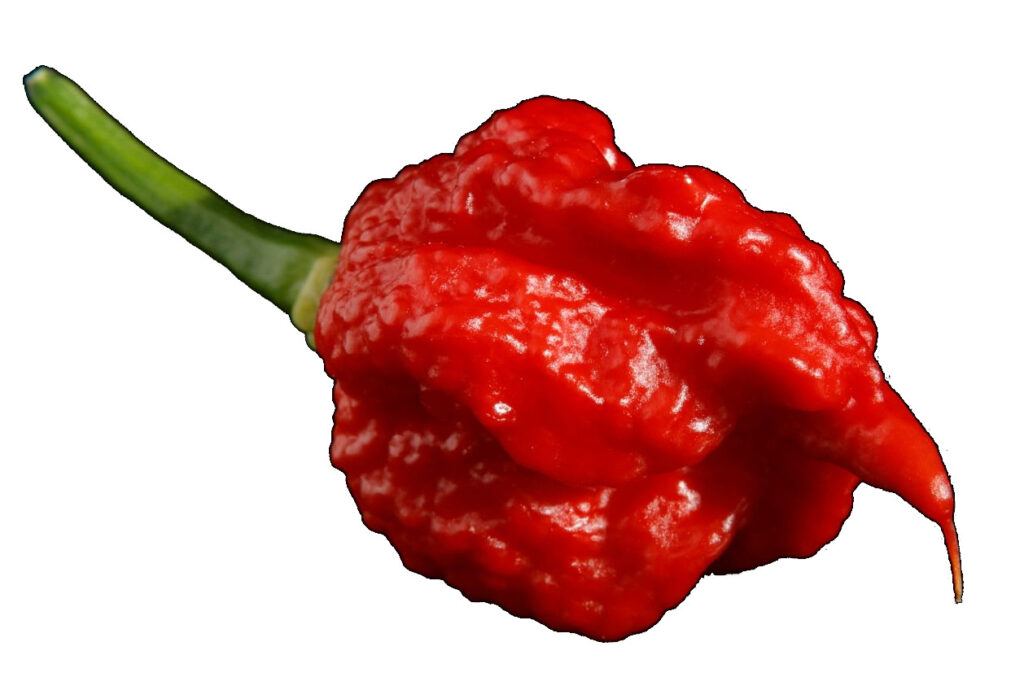
carolina reaper
The Carolina Reaper is the fiery heavyweight champion of the chili world, reigning as one of the hottest peppers ever recorded. With a heat rating that can exceed 2 million SHU, this devilish pepper doesn’t just bring the heat… it brings an inferno! Bred in South Carolina by chili breeder/grower Ed Currie (who also started the awesomely named PuckerButt Pepper Company), the Reaper earned its name for its scythe-like tail and its ability to annihilate even the bravest spice enthusiasts.
What sets the Carolina Reaper apart isn’t just its heat but its surprisingly complex flavor. Beneath the volcanic spice lies a sweet, fruity profile with hints of cherry and citrus, though you might not notice through the tears. It’s a popular choice for extremely hot sauces, chili powders, and even spicy snacks, watch out: a little goes a very long way.
Cooking with Carolina Reapers is an adventure for thrill-seekers. Wear gloves, keep milk handy, and remember that its heat doesn’t just linger; it builds, often leaving an afterburn that lasts for minutes and feels like hours! But for spice lovers who want to test their limits, the Carolina Reaper is the ultimate challenge.
About the only time you’ll see me use a Carolina Reaper is in my Dragonfire Death Paste.
the rise of the chili heads: modern chili culture
From the sweet crunch of bell peppers to the fiery intensity of superhots, the world of chilies offers a spectrum of flavors and heat levels to suit every palate. But the story of chilies goes far beyond their culinary applications.
Over the years, they have ignited a passionate subculture that celebrates the thrill of heat, the creativity of hot sauces, and the daring feats of those who push the boundaries of spice. Welcome to the rise of the chili head — a world where the love of chilies becomes an obsession, a challenge, and a way of life.
the psychology behind chili pepper madness
So what is it that drives people to willingly endure the searing pain of chili peppers, pushing their limits for increasingly spicy experiences? The answer may lie in a fascinating interplay of biology, psychology, and culture.
At the core of this phenonmenon is the body’s unique response to pain. When capsaicin triggers TRPV1 receptors and the resulting “burn” is interpreted as pain, endorphins and dopamine are released by the brain. This natural chemical cocktail creates a fleeting sense of euphoria — an addictive “high” that keeps some people coming back for more.
For others, the allure of spice lies in the thrill of risk. Eating an exceptionally spicy dish may trigger feelings of danger and discomfor, but because the stakes aren’t truly life-threatening, it provides a safe way to feel a sense of accomplishment. Psychologists refer to this as “benign masochism,” a concept that explains why some people seek out activities that simulate danger or pain, like riding roller coasters or eating ghost peppers.
The social dimension also plays a significant role. Risk-taking behaviors, including eating extremely hot foods, can earn admiration or respect, especially in group settings where daring feats are celebrated. These moments of shared challenge foster social bonding, whether it’s a friendly competition to see who can handle the most heat or a collective laugh at someone’s over-the-top reaction to a superhot chili pepper.
In the age of social media, these dynamics are amplified. Platforms like Instragram and TikTok provide a stage where daring chili feats can garner likes, shares, and positive comments, reinforcing the behavior. The drive to showcase extreme spice tolerance or partake in viral chili challenges often stems from a desire to earn social validation and build an online persona of toughness or adventurousness.
Personality traits also influence chili pepper enthusiasm. Research suggests that sensation-seekers, reward-seekers, and individuals with aggressive tendencies may gravitate toward spicy foods more than others. For these individuals, the combination of heat-induced euphoria and the thrill of the challenge creates a uniquely rewarding experience. Finally, cultural influences shape the relationship with spice. In many cuisines, chilies symbolize more than just flavor; they represent resilience, strength, and even community identity. This cultural context, combined with the psychological appeal, explains why chili pepper madness continues to captivate and connect people around the world.
Finally, cultural influences shape the relationship with spice. In many cuisines, chilies symbolize more than just flavor; they represent resilience, strength, and even community identity. This cultural context, combined wtih the psychological appeal, explains why chili pepper madness continues to captivate and connect people around the world.
the hot sauce boom
Hot sauce has transcended its humble roots as a simple condiment, evolving into a global obsession and cultural phenomenon. What was once a niche market is now a booming industry fueled by innovation, creativity, and the thrill of heat.
At the heart of the hot sauce boom is the rise of iconic sauces that have become household names. Classics like Tabasco and Sriracha paved the way, introducing mainstream audiences to the joys of adding a fiery kick to everyday meals. In recent years, small-batch, artisanal sauces have surged in popularity, offering bold flavor profiles and heat levels that cater to both casual fans and die-hard chili heads.
Social media has played a pivotal role in this explosion of interest, turning hot sauces like The Last Dab, Da Bomb Beyond Insanity, and Carolina Reaper Madness into viral sensations and elevating them to cult status. And no discussion of the hot sauce boom would be complete without mentioning Hot Ones, the wildly popular series where celebrities face off against progressively spicier wings. For fans, watching their favorite stars sweat and struggle over bottles of fiery sauces is both hilarious and relatable, while the sauces featured on the show often sell out within hours of an episode airing.
This combination of culinary artistry, viral moments, and media-driven hype has made hot sauce more than a food product — it’s a lifestyle. Whether it’s drizzled on tacos, added to ramen, or collected like vintage wines, hot sauce has cemented its place as a fiery expression of individuality and adventure.
the allure of record-breaking peppers
The quest to grow hotter and hotter chili peppers is as much about innovation as it is about obsession. For decades, farmers, scientists, and spice enthusiasts have been pushing the limits of capsaicin content, creating pepper varieties that challenge the boundaries of human endurance.
This fiery race began with natural hybrids like the Red Savina habanero, which held the title of the world’s hottest pepper in the 1990s. But as interest in extreme heat grew, pepper breeders turned to more deliberate methods, cross-pollinating strains to amplify their heat levels. The results include modern superhots like the Bhut Jolokia (ghost pepper), Trinidad Moruga Scorpion, and the infamous Carolina Reaper, each one hotter than the last.
What drives this relentless pursuit of heat? For many, it’s the thrill of discovery—unlocking new levels of spiciness and creating peppers that are as unique in flavor as they are in heat. Cultivators experiment with genetics, soil conditions, and growing techniques to achieve peppers with increasingly concentrated levels of capsaicin. These efforts are often rewarded with global recognition, as Guinness World Records continues to certify the “hottest pepper” title, currently held by Pepper X.
Beyond the scientific and agricultural challenges, the appeal lies in the pepper’s mystique. Each new superhot becomes a sensation, capturing the attention of chili heads eager to test their limits and enthusiasts drawn to the novelty of something unprecedented. Superhot peppers also inspire a wave of innovation in the culinary world, with hot sauces, spicy snacks, and fiery recipes designed to showcase their power.
However, the allure isn’t just about creating unbearable heat—it’s also about the artistry of breeding. Pepper growers carefully balance flavor and fire, crafting chilies that aren’t just painfully spicy but also offer unique taste profiles. The Carolina Reaper, for example, combines its legendary heat with a surprising sweetness, making it a favorite among hot sauce creators.
Ultimately, the pursuit of ever-hotter peppers is a fiery fusion of science, artistry, and adventure that keeps the chili world ablaze, one scorching pepper at a time.
tips for aspiring chili heads
choose your own adventure: which chili to use
These days we have an insane variety of chilies to choose from at almost any grocery store. I confess that I judge a store (or even a chain of stores) on how well-stocked their pepper section is (and how pretty!) And if you make a trip to an international market… well, the options can be overwhelming. And that doesn’t even count the huge selection of dried chilies you can find almost anywhere (seriously; we used to have a 7-Eleven down the street that had a rack of them!)
Ultimately, if the end result is enjoyable, you picked the right chili! But if you’re looking to match particular varieties with dishes in which they can really shine, it’s worth considering your options. After all, using a bell pepper to make a salsa could be thought a little… underwhelming? And you probably shouldn’t make the family Christmas breakfast casserole with ghost peppers!
Besides considering the heat level, there is a secondary layer of flavors that varies distinctly between certain pepper cultivars.
how to prep and cut fresh chilies
wash and pat dry
As the ol’ bean bag says: chilies are an agricultural product. This means they’re grown in dirt; exposed to insects; harvested, packed, and sorted by farm workers; handled by market or grocery employees; and picked over by customers who got to them before you could.
So… yeah. Wash your chilies, people.
make the cut
When preparing fruits like chilies, the usual considerations are getting them to cook evenly and making them look presentable. But with chilies, your knife can be a tool to influence not just the appearance, but the heat they bring to a dish. The cut you choose can vary the heat level, cooking time, and even the dish’s final texture. Your recipe, your mood, or even who will be enjoying your meal can help guide your choice of pepper and method of preparation.
Slicing a chili pepper into rings, for instance, is a simple way to experience the purest form of its flavor and heat. It’s perfect for dishes where you want the chili’s heat to be noticeable but not overwhelming. The rings are also visually appealing, adding a bit of flair to stir-fries or salads.
On the other hand, finely chopping or mincing a pepper allows its heat and flavor to spread throughout your dish. This cut works well in stews, sauces, or salsas, where you want the chili’s presence to be more subtle but still impactful. If you’re looking for a more intense heat, leave the membrane and seeds intact; if you prefer a milder version, remove them before chopping.
For more robust preparations, like stuffing peppers or roasting, consider slicing lengthwise or cutting larger pieces. The larger pieces take longer to cook, but their heat is more concentrated, and they retain their form better, making them ideal for stuffed peppers or grilling.
Alternatively, grinding or pounding chilies in a molcajete or with a mortar and pestle helps release their oils and intensify their flavor. This method is excellent for creating pastes or sauces and allows you to control the texture of your chili mixture, whether you want a smooth or chunky result.
By adjusting how you cut and whether you remove the seeds and membranes, you can tailor your chili to suit any recipe—whether you’re looking for a fiery kick in chili con carne or a mild, smoky flavor for stuffed peppers.
timing is everything
When it comes to chilies, timing can significantly impact their flavor, heat intensity, and the overall outcome of your dish. The moment you add them—whether raw, cooked, or as a finishing touch—can alter their role in the flavor profile of your creation.
For instance, tossing diced raw chilies directly into a salsa at the start preserves their crisp texture and delivers a bright, fresh heat. This approach is ideal for uncooked dishes where the chili’s raw essence takes center stage.
On the other hand, sautéing chilies with aromatic ingredients like onions, garlic, and cilantro—as you would for a sofrito—transforms their sharp heat into a mellow warmth while allowing the flavors to meld harmoniously. This technique is perfect for creating a flavorful base for soups, stews, or rice dishes.
If you prefer a subtler kick, you can roast or char your chilies before incorporating them, coaxing out smoky undertones and softening their bite.
Conversely, adding chilies at the very end as a garnish—such as on Ethiopian-inspired dishes, tacos, or nachos—ensures their heat and crunch remain vibrant, lending a burst of flavor and color to the finished dish.
Understanding how the timing of your chili preparation impacts the heat level, texture, and flavor allows you to tailor them to your culinary vision, elevating your dish from ordinary to extraordinary!
working with dried chilies
Rehydrating dried chili peppers is a simple yet essential technique that unlocks their deep, complex flavors and makes them easier to blend into sauces, marinades, or moles. The process is straightforward, but a few tips can elevate the results.
preparation and toasting
I like to start by putting some water on to boil in my kettle while I slip on some gloves (especially for the spicier varieties) and prep the chilies. Then I remove the stems and shake out the seeds — not to tame the heat (that’s mainly in the membranes) — but because too many seeds can add an unwelcome grittiness to the finished dish.
I prefer to toast dried chilies briefly in a dry skillet to awaken their natural oils and intensify their aroma, giving them a smoky depth that will enhance any recipe. You can also try setting them over an open flame, such as on a gas range, but honestly, I never get good results from this method; toasting in a skillet does a much better job of toasting them evenly and quickly.
soaking the chilies
Place the toasted chilies in a heatproof bowl and pour enough hot water (or broth, if you prefer) over them to fully submerge. If the chilies misbehave and float rather than staying underwater, a simple trick is to lay a butter knife or small plate on top to weigh them down.
Let them soak for 20-30 minutes, or until they become soft and pliable. The soaking time can vary depending on the chili’s size, thickness, and how dry they are… if they have been languishing in your cabinet for months and are very dried out, they may not get soft as quickly as ones that still retain some pliability (as they should). Check the soaking chilies occasionally to make sure they don’t go all mushy on you!
9.3 straining and saving the liquid
Once the chilies are rehydrated, carefully remove them with tongs and set them aside. Don’t overlook the soaking liquid — it’s packed with flavor and can be used to adjust the consistency of your dish or as a base for soups and stews. Strain the liquid through a fine-mesh sieve or cheesecloth to remove any stray bits of stem, seeds, or leaf fragments. This extra step ensures a smooth and clean addition to your recipe.
9.4 using rehydrated chilies
Now that your chilies are rehydrated, they’re ready to be blended into pastes or added whole to simmering sauces. Their softened texture allows them to meld seamlessly into dishes, infusing them with rich, earthy heat and vibrant color.
10.0 final thoughts: embrace the heat
So. We’ve taken a walk through the wild world of chili peppers! We have explored their rich history and cultural significance, the science behind their heat, and how we can harness their powerful punch to create fiery, delicious dishes.
Whether you’re a chili newbie taking your first steps into the pepper patch or a seasoned champion chili head chasing the thrill of the hottest peppers, there’s always something new to discover. Embracing chilies means not only adding heat to your dishes but also enriching your culinary experiences with their diverse flavors and stories.
Remember, the Scoville Scale is more than a measure of spiciness; it illustrates the incredible range and depth that chili peppers bring to our tables. So, as you continue your spicy adventures, savor the journey, respect the heat, and most importantly, enjoy the rich tapestry of flavors that chilies offer.


Leave a Reply